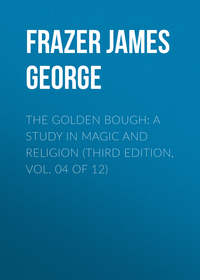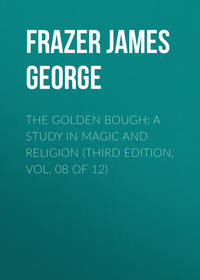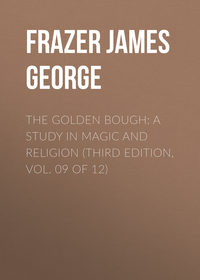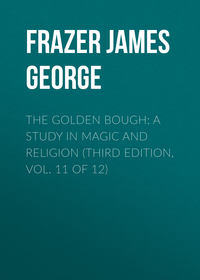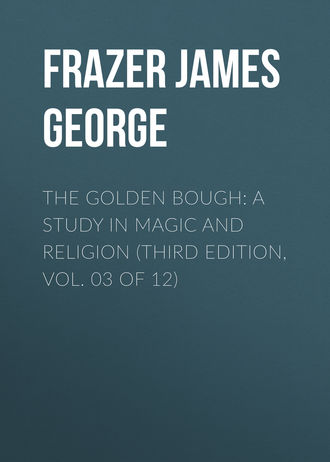 полная версия
полная версияThe Golden Bough: A Study in Magic and Religion (Third Edition, Vol. 03 of 12)
969
J. G. F. Riedel, op. cit. p. 265.
970
G. Heijmering, “Zeden en gewoonten op het eiland Rottie,” Tijdschrift voor Neêrlands Indië, 1843, dl. ii. pp. 634-637.
971
W. Dall, Alaska and its Resources (London, 1870), p. 54; F. Whymper, “The Natives of the Youkon River,” Transactions of the Ethnological Society of London, N.S., vii. (1869) p. 174.
972
E. Meier, Deutsche Sagen, Sitten und Gebräuche aus Schwaben, p. 509; A. Birlinger, Volksthümliches aus Schwaben, i. 493.
973
W. Mannhardt, Germanische Mythen, p. 630.
974
H. B. Guppy, The Solomon Islands and their Natives (London, 1887), p. 54.
975
R. H. Codrington, The Melanesians, p. 203.
976
Th. Williams, Fiji and the Fijians,2 i. 249.
977
J. G. Scott and J. P. Hardiman, Gazetteer of Upper Burma and the Shan States, part i. vol. ii. p. 37.
978
The Zend-Avesta, Vendîdâd Fargaard, xvii. (vol. i. pp. 186 sqq., translated by J. Darmesteter, Sacred Books of the East, vol. iv.).
979
Grihya-Sûtras, translated by H. Oldenberg, part i. p. 57; compare id., pp. 303, 399, part ii. p. 62 (Sacred Books of the East, vols. xxix., xxx.). Compare H. Oldenberg, Die Religion des Veda, p. 487.
980
Grihya-Sûtras, translated by H. Oldenberg, part ii. pp. 165 sq., 218.
981
R. W. Felkin, “Notes on the Madi or Moru Tribe of Central Africa,” Proceedings of the Royal Society of Edinburgh, xii. (1882-84) p. 332.
982
Fr. Stuhlmann, Mit Emin Pascha ins Herz von Afrika, p. 185 note. The same thing was told me in conversation by the Rev. J. Roscoe, missionary to Uganda; but I understood him to mean that the hair was not carelessly disposed of, but thrown away in some place where it would not easily be found.
983
Fr. Stuhlmann, op. cit. pp. 516 sq.
984
J. Macdonald, Light in Africa, p. 209; id., “Manners, Customs, Superstitions and Religions of South African Tribes,” Journal of the Anthropological Institute, xx. (1891) p. 131.
985
A. Steedman, Wanderings and Adventures in the Interior of Southern Africa (London, 1835), i. 266.
986
Emin Pasha in Central Africa, being a Collection of his Letters and Journals (London, 1888), p. 74.
987
Fr. Stuhlmann, Mit Emin Pascha ins Herz von Afrika, p. 625.
988
M. Merkel, Die Masai (Berlin, 1904), p. 243.
989
J. L. Wilson, Western Africa, p. 215.
990
Ch. Partridge, Cross River Natives (London, 1905), pp. 8, 203 sq.
991
James Teit, “The Thompson River Indians of British Columbia,” Memoir of the American Museum of Natural History, The Jesup North Pacific Expedition, vol. i. part iv. (April 1900) p. 360.
992
N. P. Wilken en J. A. Schwarz, “Allerlei over het land en volk van Bolaang Mongondou,” Mededeelingen van wege het Nederlandsche Zendelinggenootschap, xi. (1867) p. 322.
993
I. V. Zingerle, Sitten, Bräuche und Meinungen des Tiroler Volkes2 (Innsbruck, 1871), §§ 176, 580; Mélusine, 1878, col. 79; E. Monseur, Le Folklore Wallon, p. 91.
994
Pliny, Nat. Hist., xxviii. 35; Theophrastus, Characters, “The Superstitious Man”; Theocritus, id. vi. 39, vii. 127; Persius, Sat. ii. 31 sqq. At the siege of Danzig in 1734, when the old wives saw a bomb coming, they used to spit thrice and cry, “Fi, ti, fi, there comes the dragon!” in the persuasion that this secured them against being hit (Tettau und Temme, Die Volkssagen Ostpreussens, Litthauens und Westpreussens (Berlin, 1837), p. 284). For more examples, see J. E. B. Mayor on Juvenal, Sat. vii. 112; J. E. Crombie, “The Saliva Superstition,” International Folk-lore Congress, 1891, Papers and Transactions, pp. 249 sq.; C. de Mensignac, Recherches ethnographiques sur la salive et le crachat (Bordeaux, 1892), pp. 50 sqq.; F. W. Nicolson, “The Saliva Superstition in Classical Literature,” Harvard Studies in Classical Philology, viii. (1897) pp. 35 sqq.
995
Garcilasso de la Vega, First Part of the Royal Commentaries of the Yncas, bk. ii. ch. 7 (vol. i. p. 127, Markham's translation).
996
Mélusine, 1878, coll. 583 sq.
997
The People of Turkey, by a Consul's daughter and wife, ii. 250.
998
M. Abeghian, Der armenische Volksglaube, p. 68.
999
G. F. Abbott, Macedonian Folklore (Cambridge, 1903), p. 214.
1000
M. Quedenfelt, “Aberglaube und halbreligiöse Bruderschaft bei den Marokkanern,” Verhandlungen der Berliner Gesellschaft für Anthropologie, Ethnologie und Urgeschichte, 1886, p. (680).
1001
Le P. A. Jaussen, Coutumes des Arabes au pays de Moab (Paris, 1908), p. 94 note 1.
1002
Boecler-Kreutzwald, Der Ehsten abergläubische Gebräuche, Weisen und Gewohnheiten, p. 139; F. J. Wiedemann, Aus dem innern und äussern Leben der Ehsten, p. 491.
1003
L. F. Sauvé, Le Folk-lore des Hautes-Vosges (Paris, 1889), p. 41.
1004
Miss A. H. Singleton, in a letter to me, dated Rathmoyle House, Abbeyleix, Ireland, 24th February 1904.
1005
Dr. Antoine Petit, in Th. Lefebvre, Voyage en Abyssinie, i. 373.
1006
J. J. M. de Groot, The Religious System of China, i. 342 sq. (Leyden, 1892).
1007
R. W. Felkin, “Notes on the For Tribe of Central Africa,” Proceedings of the Royal Society of Edinburgh, xiii. (1884-86) p. 230.
1008
A. D'Orbigny, Voyage dans l'Amérique méridionale, ii. 93; Lieut. Musters, “On the Races of Patagonia,” Journal of the Anthropological Institute, i. (1872) p. 197; J. Dawson, Australian Aborigines, p. 36. The Patagonians sometimes throw their hair into a river instead of burning it.
1009
L. F. Sauvé, Le Folk-lore des Hautes-Vosges, p. 170.
1010
Z. Zanetti, La Medicina delle nostre donne (Città di Castello, 1892), pp. 234 sq.
1011
A. B. Ellis, The Ewe-speaking Peoples of the Slave Coast, p. 99; Miss Mary H. Kingsley, Travels in West Africa, p. 447; R. H. Nassau, Fetichism in West Africa (London, 1904), p. 83; A. F. Mockler-Ferryman, British Nigeria (London, 1902), p. 286; David Livingstone, Narrative of Expedition to the Zambesi, pp. 46 sq.; W. Ellis, Polynesian Researches,2 i. 365. In some parts of New Guinea cut hair is destroyed for the same reason (H. H. Romilly, From my Verandah in New Guinea, London, 1889, p. 83).
1012
W. H. Furness, The Island of Stone Money, Uap of the Carolines (Philadelphia and London, 1910), P. 137.
1013
Fr. Stuhlmann, Mit Emin Pascha ins Herz von Afrika, p. 451.
1014
W. E. Roth, North Queensland Ethnography, Bulletin No. 5 (Brisbane, 1903), p. 21.
1015
Captain R. Fitzroy, Narrative of the Surveying Voyages of His Majesty's Ships Adventure and Beagle, i. (London, 1839). pp. 313 sq.
1016
J. Teit, “The Thompson Indians of British Columbia,” Memoir of the American Museum of Natural History, The Jesup North Pacific Expedition, vol. i. part iv. (April 1900) p. 360.
1017
I. V. Zingerle, Sitten, Bräuche und Meinungen des Tiroler Volkes2 (Innsbruck, 1871), p. 28, §§ 177, 179, 180.
1018
U. Jahn, Hexenwesen und Zauberei in Pommern (Breslau, 1886), p. 15; Mélusine, 1878, col. 79; E. Monseur, Le Folklore Wallon, p. 91.
1019
E. H. Meyer, Indogermanische Mythen, ii. Achilleis (Berlin, 1877), p. 523.
1020
P. Lowell, Chosön, the Land of the Morning Calm, a Sketch of Korea (London, Preface dated 1885), pp. 199-201; Mrs. Bishop, Korea and her Neighbours (London, 1898), ii. 55 sq.
1021
Above, p. 276.
1022
Above, pp. 4, 131, 139, 145, 156.
1023
W. Ridley, “Report on Australian Languages and Traditions,” Journal of the Anthropological Institute, ii. (1873) p. 268.
1024
Fr. Stuhlmann, Mit Emin Pascha ins Herz von Afrika, p. 795.
1025
F. de Castelnau, Expédition dans les parties centrales de l'Amérique du Sud, v. (Paris, 1851) p. 46.
1026
J. Roscoe, “Further Notes on the Manners and Customs of the Baganda,” Journal of the Anthropological Institute, xxxii. (1902) p. 34.
1027
See G. A. Wilken, Über das Haaropfer und einige andere Trauergebräuche bei den Völkern Indonesiens, pp. 94 sqq. (reprinted from the Revue Coloniale Internationale, Amsterdam, 1886-87); H. Ploss, Das Kind in Brauch und Sitte der Völker,2 i. 289 sqq.; K. Potkanski, “Die Ceremonie der Haarschur bei den Slaven und Germanen,” Anzeiger der Akademie der Wissenschaften in Krakau, May 1896, pp. 232-251.
1028
Above, p. 261.
1029
Above, pp. 111 sqq.
1030
J. Campbell, Travels in South Africa, Second Journey (London, 1822), ii. 205.
1031
H. Oldenberg, Die Religion des Veda, pp. 426 sq.
1032
L. F. Alfred Maury, “Les Populations primitives du nord de l'Hindoustan,” Bulletin de la Société de Géographie (Paris), IVme Série, vii. (1854) p. 197.
1033
Lucian, De dea Syria, 53.
1034
A. B. Ellis, The Ewe-speaking Peoples of the Slave Coast, p. 160.
1035
W. H. Furness, Folk-lore in Borneo (Wallingford, Pennsylvania, 1899; privately printed), p. 28.
1036
B. Gutmann, “Trauer und Begräbnissitten der Wadschagga,” Globus, lxxxix. (1906) p. 198.
1037
Miss A. Werner, The Natives of British Central Africa (London, 1906), pp. 165, 166, 167.
1038
J. M. Hildebrandt, “Ethnographische Notizen über Wakamba und ihre Nachbarn,” Zeitschrift für Ethnologie, x. (1878) p. 395. Children who are born in an unusual position, the second born of twins, and children whose upper teeth appear before the lower, are similarly exposed by the Akikuyu. The mother is regarded as unclean, not so much because she has exposed, as because she has given birth to such a child.
1039
Monier Williams, Religious Thought and Life in India, p. 375.
1040
Strabo, xii. 2. 3, p. 535; Pausanias, viii. 34. 3. In two paintings on Greek vases we see Apollo in his character of the purifier preparing to cut off the hair of Orestes. See Monumenti inediti, 1847, pl. 48; Annali dell' Instituto di Corrispondenza Archeologica, 1847, pl. x.; Archaeologische Zeitung, 1860, pll. cxxxvii. cxxxviii.; L. Stephani, in Compte rendu de la Commission archéologique (St. Petersburg), 1863, pp. 271 sq.
1041
C. Martin, “Über die Eingeborenen von Chiloe,” Zeitschrift für Ethnologie, ix. (1877) pp. 177 sq.
1042
J. Mooney, “Sacred Formulas of the Cherokees,” Seventh Annual Report of the Bureau of Ethnology (Washington, 1891), pp. 392 sq.
1043
B. C. A. J. van Dinter, “Eenige geographische en ethnographische aanteekeningen betreffende het eiland Siaoe,” Tijdschrift voor Indische Taal- Land- en Volkenkunde, xii. (1899) p. 381.
1044
A. W. Howitt, “On Australian Medicine-men,” Journal of the Anthropological Institute, xvi. (1887) p. 27; id., Native Tribes of South-east Australia, p. 365.
1045
E. Dieffenbach, Travels in New Zealand (London, 1843), ii. 59.
1046
Rev. J. Macdonald, Light in Africa, p. 209; id., in Journal of the Anthropological Institute, xx. (1891) p. 131.
1047
C. le Gobin, Histoire des Isles Marianes (Paris, 1700), p. 52. The writer confesses his ignorance of the reason of the custom.
1048
C. de Mensignac, Recherches ethnographiques sur la salive et le crachat (Bordeaux, 1892), pp. 48 sq.
1049
Vahness, reported by F. von Luschan, in Verhandlungen der Berliner Gesellschaft für Anthropologie, Ethnologie und Urgeschichte, 1900, p. (416).
1050
K. Vetter, Komm herüber und hilf uns! iii. (Barmen, 1898) pp. 9 sq.
1051
Indian Antiquary, xxviii. (1899) pp. 83 sq.
1052
W. Ellis, Polynesian Researches,2 i. 365.
1053
A. B. Ellis, The Ewe-speaking Peoples of the Slave Coast, p. 99.
1054
C. Partridge, Cross River Natives (London, 1905), p. 8.
1055
A. Raffenel, Voyage dans l'Afrique occidentale (Paris, 1846), p. 338.
1056
C. de Mensignac, op. cit. p. 48.
1057
Mission Evangelica al reyno de Congo por la serafica religion de los Capuchinos (Madrid, 1649), p. 70 verso.
1058
R. Andree, Ethnographische Parallelen und Vergleiche, Neue Folge (Leipsic, 1889), p. 13.
1059
F. W. Christian, The Caroline Islands (London, 1899), pp. 289 sq.
1060
R. Southey, History of Brazil, i.2 (London, 1822) pp. 127, 138.
1061
J. Raum, “Blut und Speichelbünde bei den Wadschagga,” Archiv für Religionswissenschaft, x. (1907) pp. 290 sq.
1062
Above, pp. 13 sq.
1063
Porphyry, De abstinentia, iii. 18.
1064
A. Bastian, Die deutsche Expedition an der Loango-Küste, ii. 170. The blood may perhaps be drunk by them as a medium of inspiration. See The Magic Art and the Evolution of Kings, vol. i. pp. 381 sqq.
1065
O. Dapper, Description de l'Afrique, p. 336.
1066
T. J. Hutchinson, Impressions of Western Africa (London, 1858), p. 198.
1067
M. Merker, Die Masai (Berlin, 1904), p. 21.
1068
J. G. Frazer, Totemism and Exogamy, ii. 526 sqq., from information furnished by the Rev. J. Roscoe.
1069
G. Watt (quoting Col. W. J. M'Culloch), “The Aboriginal Tribes of Manipur,” in Journal of the Anthropological Institute, xvi. (1887) p. 360.
1070
T. C. Hodson, “The Native Tribes of Manipur,” Journal of the Anthropological Institute, xxxi. (1901) p. 306.
1071
Indian Antiquary, xxi. (1892) pp. 317 sq.; (Sir) J. G. Scott and J. P. Hardiman, Gazetteer of Upper Burma and the Shan States, part ii. vol. i. p. 308.
1072
“Die Pschawen und Chewsuren im Kaukasus,” Zeitschrift für allgemeine Erdkunde, ii. (1857) p. 76.
1073
A. Senfft, “Ethnographische Beiträge über die Karolineninsel Yap,” Petermanns Mitteilungen, xlix. (1903) p. 54. In Gall, another village of the same island, the people grow bananas for sale, but will not eat them themselves, fearing that if they did so the women of the village would be barren (ibid.).
1074
Aulus Gellius, x. 15. 6 and 9. See above, p. 13.
1075
E. Doutté, Magie et religion dans l'Afrique du Nord, pp. 87 sq.
1076
J. Hillner, Volksthümlicher Brauch und Glaube bei Geburt und Taufe im Siebenbürger Sachsenlande, p. 15. This tractate (of which I possess a copy) appears to be a programme of the High School (Gymnasium) at Schässburg in Transylvania for the school year 1876-1877.
1077
C. Leemius, De Lapponibus Finmarchiac eorumque lingua, vita, et religione pristina commentatio (Copenhagen, 1767), p. 494.
1078
W. Caland, Altindisches Zauberritual (Amsterdam, 1900), p. 108.
1079
Servius on Virgil, Aen. iii. 518.
1080
J. Kreemer, “Hoe de Javaan zijne zieken verzorgt,” Mededeelingen van wege het Nederlandsche Zendelinggenootschap, xxxvi. (1892) p. 114; C. M. Pleyte, “Plechtigheden en gebruiken uit den cyclus van het familienleven der volken van den Indischen Archipel,” Bijdragen tot de Taal- Land- en Volkenkunde van Nederlandsch-Indië, xli. (1892) p. 586.
1081
H. Ling Roth, The Natives of Sarawak and British North Borneo, i. 98.
1082
Spenser St. John, Life in the Forests of the Far East,2 i. 170.
1083
J. G. F. Riedel, “Alte Gebräuche bei Heirathen, Geburt und Sterbefällen bei dem Toumbuluh-Stamm in der Minahasa (Nord Selebes),” Internationales Archiv für Ethnographie, viii. (1895) pp. 95 sq.
1084
Spencer and Gillen, Northern Tribes of Central Australia, pp. 606 sq.
1085
J. Spieth, Die Ewe-Stämme, p. 692.
1086
J. Spieth, Die Ewe-Stämme, pp. 433 sq.
1087
J. A. E. Köhler, Volksbrauch, Aberglauben, Sagen und andre alte Überlieferungen im Voigtlande, pp. 435 sq.; A. Wuttke, Der deutsche Volksaberglaube,2 p. 355, § 574.
1088
J. G. Campbell, Superstitions of the Highlands and Islands of Scotland, p. 37. note 1.
1089
Festus, p. 56, ed. C. O. Müller.
1090
G. F. D'Penha, “Superstitions and Customs in Salsette,” Indian Antiquary, xxviii. (1899) p. 115.
1091
H. Ris, “De onderafdeeling Klein Mandailing Oeloe en Pahantan en hare Bevolking,” Bijdragen tot de Taal- Land- en Volkenkunde van Nederlandsch-Indië, xlvi. (1896) p. 503. Compare A. L. van Hasselt, Volksbeschrijving van Midden Sumatra, p. 266.
1092
J. H. Meerwaldt, “Gebruiken der Bataks in het maatschappelijk leven,” Mededeelingen van wege het Nederlandsche Zendelinggenootschap, xlix. (1905) p. 117.
1093
H. K[ern], “Bijgeloof onder de inlanders in den Oosthoek van Java,” Tijdschrift voor Indische Taal- Land- en Volkenkunde, xxvi. (1880) 310; J. Kreemer, “Hoe de Javaan zijne zieken verzorgt,” Mededeelingen van wege het Nederlandsche Zendelinggenootschap, xxxvi. (1892) pp. 120, 124; D. Louwerier, “Bijgeloovige gebruiken, die door de Javanen worden in acht genomen bij de verzorging en opvoeding hunner kinderen,” Mededeelingen van wege het Nederlandsche Zendelinggenootschap, xlix. (1905) p. 253.
1094
A. W. P. V. Pistorius, Studien over de inlandsche huishouding in de Padangsche Bovenlanden (Zalt-Bommel, 1871), pp. 55 sq.; A. L. van Hasselt, Volksbeschrijving van Midden-Sumatra (Leyden, 1882), p. 266; J. G. F. Riedel, De sluik- en kroesharige rassen tusschen Selebes en Papua (the Hague, 1886), pp. 135, 207, 325.
1095
Th. Bérengier, “Croyances superstitieuses dans le pays de Chittagong,” Missions Catholiques, xiii. (1881) p. 515.
1096
Damien Grangeon, “Les Chams et leurs superstitions,” Missions Catholiques, xxviii. (1896) p. 93.
1097
A. A. Perera, “Glimpses of Singhalese Social Life,” Indian Antiquary, xxxi. (1902) p. 378.
1098
B. Pilsudski, “Schwangerschaft, Entbindung und Fehlgeburt bei den Bewohnern der Insel Sachalin,” Anthropos, v. (1910) p. 759.
1099
E. M. Gordon, Indian Folk Tales (London, 1908), p. 39.
1100
R. Campbell Thompson, Semitic Magic (London, 1908), p. 169.
1101
Pliny, Nat. Hist. xxviii. 59. Compare Hippocrates, De morbo sacro, μηδὲ πόδα ἐπὶ ποδὶ ἔχειν, μηδὲ χεῖρα ἐπὶ χειρί; ταῦτα γὰρ πάντα κωλύματα εἶναι (vol. i. p. 589, ed. Kühn, Leipsic, 1825, quoted by E. Rohde, Psyche,3 ii. 76 note 1).
1102
Ovid, Metam. ix. 285 sqq. Antoninus Liberalis, quoting Nicander, says it was the Fates and Ilithyia who impeded the birth of Hercules, but though he says they clasped their hands, he does not say that they crossed their legs (Transform. 29). Compare Pausanias, ix. 11. 3.
1103
A. Strausz, Die Bulgaren (Leipsic, 1898), p. 293.
1104
F. Panzer, Beitrag zur deutschen Mythologie, ii. 303.
1105
J. Grimm, Deutsche Mythologie,4 ii. 897, 983; J. Brand, Popular Antiquities, iii. 299; J. G. Dalyell, Darker Superstitions of Scotland, pp. 302, 306 sq.; B. Souché, Croyances, présages et traditions diverses, p. 16; J. G. Bourke, in Ninth Annual Report of the Bureau of Ethnology (Washington, 1892), p. 567.


